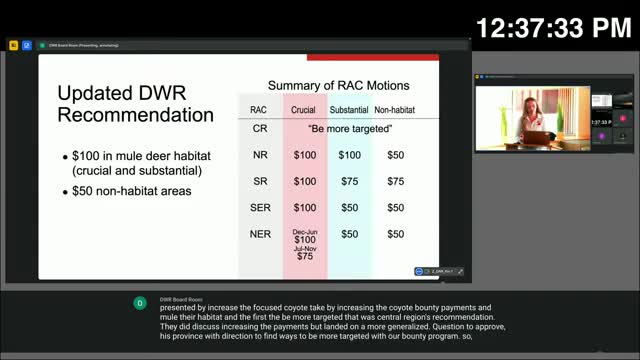Wildlife Division proposes $100 coyote bounty in crucial mule deer habitats
January 09, 2025 | Utah Office of Tourism, Utah Governor's Office of Economic Opportunity, Offices, Departments, and Divisions, Organizations, Utah Executive Branch, Utah
Thanks to Excel Chiropractic and Scribe from Workplace AI , all articles about Utah are free for you to enjoy throughout 2025!

This article was created by AI using a video recording of the meeting. It summarizes the key points discussed, but for full details and context, please refer to the video of the full meeting. Link to Full Meeting
The meeting included a detailed presentation of a map highlighting crucial (red) and substantial (blue) habitats, along with a yellow heat map indicating coyote kills from the previous fiscal year. The recommendation aims to be both biologically sound and fiscally responsible, with an allocated budget of approximately $250,000 to support these bounties. The inclusion of substantial areas is expected to enhance access and participation in the program, particularly in southern regions where deer herds are prevalent.
Public input was also a significant aspect of the meeting, with seven online submissions supporting the proposed bounty increases. Some comments suggested extending the bounty program to other predators, such as cougars and bears, and proposed longer trap check intervals to incentivize targeting coyotes. Safari Club International expressed support for the amendments and suggested removing certain check-in requirements to streamline the process.
The RACs provided their feedback, with the southern region passing a motion to accept the proposal as presented, while also suggesting a $75 bounty in non-crucial areas. In contrast, the southeastern region had a more contentious discussion, ultimately deciding to maintain the $50 bounty in non-habitat areas while agreeing to the $100 payment in crucial areas.
In conclusion, the meeting underscored the importance of public engagement in wildlife management decisions and the ongoing efforts to balance predator control with the conservation of mule deer populations. The board will continue to monitor the program's effectiveness and consider further adjustments based on public and RAC feedback.
Converted from Wildlife Board Meeting 01/9/2025 meeting on January 09, 2025
Link to Full Meeting
Comments
View full meeting
This article is based on a recent meeting—watch the full video and explore the complete transcript for deeper insights into the discussion.
View full meeting

